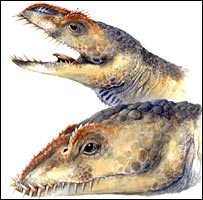Australia was once home to reptiles that swam in glacial lakes. This is evident from a number of recently discovered fossils.

Australia was once home to reptiles that swam in glacial lakes. This is evident from a number of recently discovered fossils. The giant meat-eating lizard lived 115 million years ago, during the time of the dinosaurs when most of the continent was covered by water.
Fossils of two new species of plesiosaur have been discovered near Coover Pedy in South Australia.
Plesiosaurs are popular creatures in science fiction books because they seem to have somewhat resembled the mythological monster Loch Ness. The Australian details are described in the latest issues of the journals Biology Letters and Palaeontology.
The length of one of these species, called Umoonasaurus demoscyllus, is 2.4 meters and it also had a large crest on its head, which was probably used to gain a reproductive advantage.
According to the lead researcher on both papers, Dr. Benjamin Kier of Adelheid University, the reptiles swam in the shallow waters of a sea that once existed in central Australia. A sea covered large parts of Australia 115 million years ago, when it was located closer to Antarctica.
The Omnosaurus was 2.4 meters long, and on its skull there were three grooves similar to a crown.
"Imagine a compact body with four fins, a long lizard neck, a small head and a short tail, almost like a crawling seal" said Kir.
The other species, Opallionectes andamookaensis stood 5 meters long and had small needle-like teeth.
About 30 fossils were discovered in a mine near the isolated mining town of Coober Pedy.
The genus Plesiosaurus is a type of extinct marine reptile with a long neck, small head, short tail and four limbs - probably fins. They first appeared at the beginning of the Jurassic period, and survived until 65 million years ago, when they became extinct along with all the dinosaurs and most species of life on Earth. The mineral opal filled the voids created when the bones decayed as the original rock that contained the fossils was washed away by the acidic groundwater. In the fossils are several skeletons as well as a complete skull of Umoonasaurus and a partial skeleton of Opallionectes.
It seems that these are young individuals, and this indicates that the lake was probably a spawning and breeding area for these reptiles. The scientists believe that the adults who lived in the sea returned to the shallow waters to breed and raise the young. At that time, Australia was a much colder place and the inland ocean was frozen in many areas during the winter.
The scientists believe that the creatures developed mechanisms that allowed them to survive in the harsh climate, such as a faster metabolic rate. They were meat eaters and fed on fish and squid.
